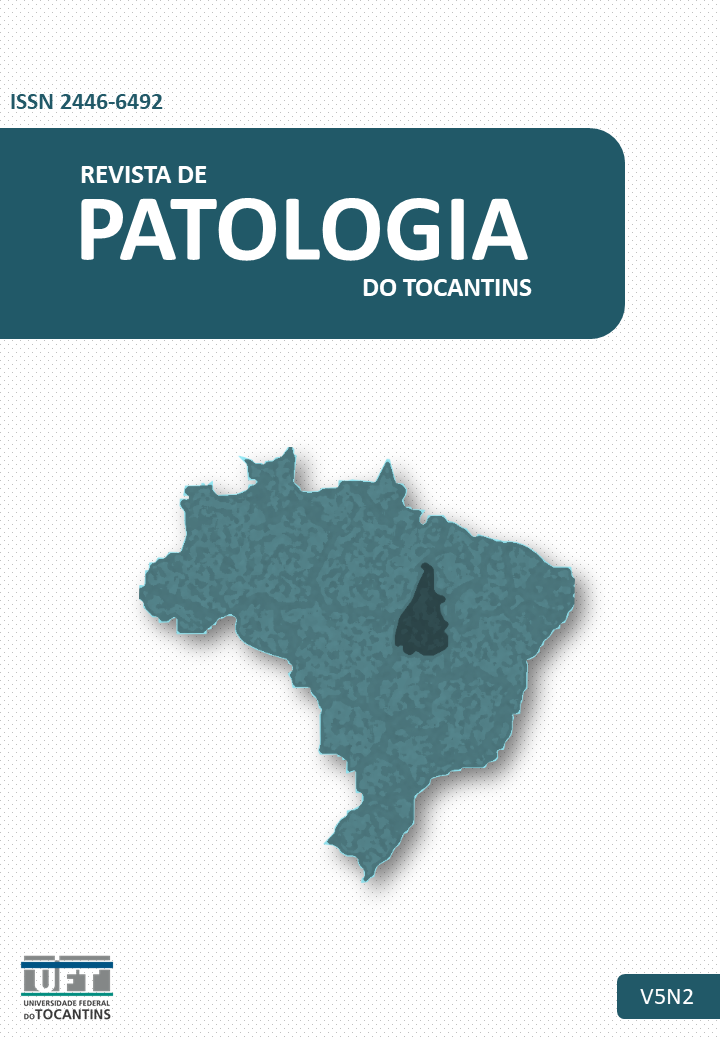SÍNDROME DE BART NA INFÂNCIA
UM RELATO DE CASO
DOI:
https://doi.org/10.20873/uft.2446-6492.2018v5n2p50Resumo
RESUMO
Introdução: A Síndrome de Bart é uma herança autossômica dominante, que ocorre devido à mutação no gene do colágeno tipo VII no cromossomo, sendo caracterizada por ausência localizada de pele (presente ao nascimento), epidermólise bolhosa (EB) e alterações ungueais. Objetivo: Relatar um caso clínico de paciente de 5 anos assistida na Policlínica, Gurupi-TO, com diagnostico tardio de epidermolise bolhosa. Método: Estudo descritivo, sobre o curso clínico da síndrome cuja ocorrência vem desde o nascimento, abordando sobre o diagnóstico, a escolha terapêutica e os principais diagnósticos diferenciais. As informações foram obtidas na Policlínica, por meio de revisão de prontuário, obtenção de registro fotográfico e análise de exames. Resultados: O diagnóstico da Síndrome de Bart é clínico e foi realizado pelas alterações características, porém houve biópsia para confirmação de EB após 5 anos do nascimento. O tratamento foi feito com curativos, pomadas e cremes nos locais afetados, evitando-se traumas nas regiões. Houve o aconselhamento da mãe e da enfermeira acerca dos cuidados com a pele. Conciderações finais: A transmissão de conhecimento sobre as patologias menos frequentes se mostra essencial para o levantamento da hipótese diagnóstica correta e o tratamento precoce. Desse modo, quando um médico deparar-se com um recém-nascido apresentando a tríade (aplasia cutânea, epidermólise bolhosa e alterações ungueais), deverá iniciar as medidas gerais bem como acompanhamento multidisciplinar, sendo essencial o diagnóstico precoce a fim de garantir um melhor prognóstico ao paciente.
Palavras-chave: Epidermólise bolhosa, Aplasia Cutânea, Mutação.
ABSTRACT
Introduction: Bart's syndrome is an autosomal dominant inheritance, due to the mutation in the type VII collagen gene in the chromosome. It is characterized by localized absence of skin (present at birth), epidermolysis bullosa (EB) and nail abnormalities. Objective: To report a clinical case of a 5-year-old patient assisted in the Policlínica, Gurupi-TO, with late diagnosis of epidermolysis bullosa. Method: A descriptive study about the clinical course of the syndrome whose occurrence comes from birth, addressing the diagnosis, the therapeutic choice and the main differential diagnoses. The information was obtained at the Policlínica, through a review of medical records, obtaining a photographic record and exam analysis. Results: The diagnosis of Bart syndrome was clinical and was performed by the characteristic alterations, but there was a biopsy to confirm EB after 5 years of birth. The treatment was done with dressings, ointments and creams in the affected places, avoiding traumas in the regions. The mother and the nurse were advised of skin care. Final concluding remarks: The transmission of knowledge about the less frequent pathologies is essential for the collection of the correct diagnostic hypothesis and the early treatment. Thus, when a physician encounters a newborn presenting the triad (cutaneous aplasia, epidermolysis bullosa and nail abnormalities), he should initiate general measures as well as multidisciplinary follow-up, with an early diagnosis essential in order to guarantee a better prognosis to the patient.
Keywords: Epidermolysis bullosa, Cutaneous Aplasia, Mutation.
Downloads
Publicado
Como Citar
Edição
Seção
Licença
Os autores declaram para os devidos fins de direito e obrigações, sob as penas previstas na Legislação vigente, que são autores/detentores dos Direitos Autorais do trabalho proposto nos termos dos artigos 28 a 33 da Lei Federal nº9.610 de 19 de fevereiro de 1998 (Lei dos Direitos Autorais).








